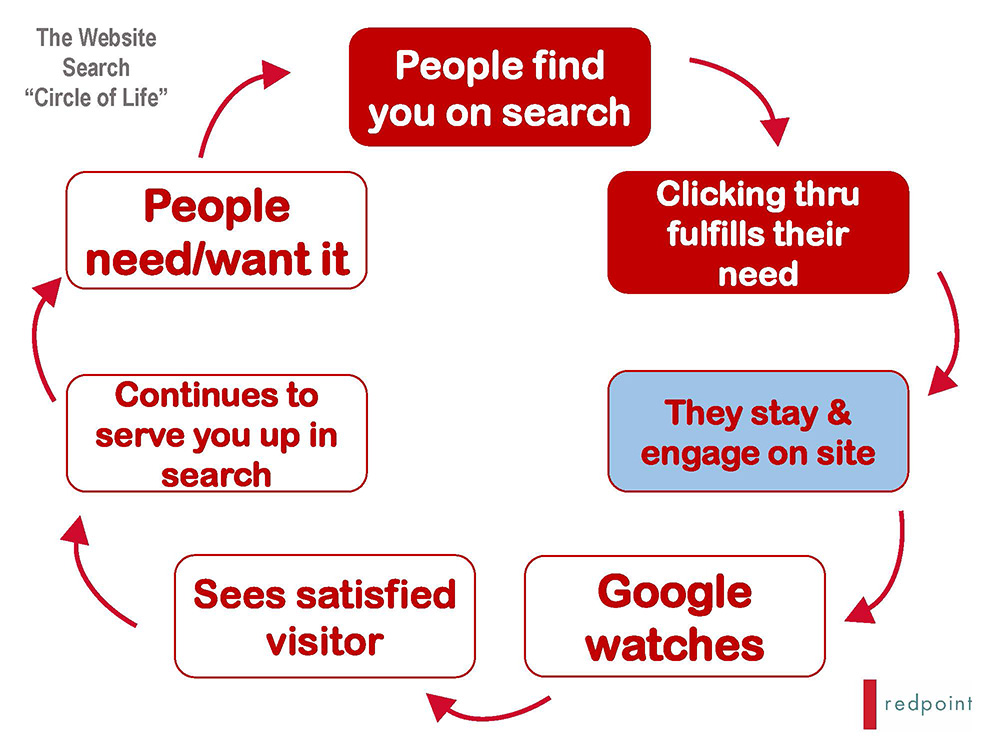Your website’s bounce rate is something you should care deeply about, and here at Redpoint we call it “the sneaky little stat” for two reasons:
- It’s one single metric that gives clues to a ton of things that could be out of whack on your website.
- Google doesn’t actually LOOK at your bounce rate, yet it’s a supremely important factor in your search ranking potential. (note: for brevity, I’m just saying “Google” instead of “Google and other search engines,” but this blog post applies to all of them.)
First, what’s a bounce rate? It’s the percentage of visitors who come to your site and leave after visiting just one page with no interactions. So, if your bounce rate is 87%, that means 87% of the people who came to your site basically opened the door, peeked their head inside, and then turned around and left <sound of door slamming>. This ain’t good, folks. In this example, 87% of the people you lured to your door (and you probably spent some marketing dollars to get them there) weren’t interested enough to come inside your house and get to know you better.
Acceptable bounce rates can vary by industry, type of business, and purpose of website, but here are some general benchmarks to help measure yours:
- 26-40%: Excellent
- 41-55%: Average, with potential
- 56-70%: Definitely room to improve
- 71%+: Something’s wrong, fix it pronto
But why should you care about your website’s bounce rate if Google doesn’t actually look at it? Because your bounce rate is influenced by many critical factors, and those factors are things Google DOES care about…a LOT. Here are a few important things that can negatively impact your bounce rate:
- How fast the pages of your website load. We’ve all been peeved by websites that take sooooo long to load that we leave before the first page even finishes loading. Google uses site speed among its ranking factors…it likes websites to be fast.
- The amount of time people spend on your site. There’s no magic number (i.e. 5 minutes) that Google wants you to hit. But in the simplest of terms, Google sees people staying on your site longer as an indication that your website delivers a satisfactory experience for users. And Google’s entire goal is to return relevant and satisfactory results when people are searching. So let’s say a lot of people searching for “charming country inns that allow pets” spend a lot of time on your site after they click through on the search engine results page. Ultimately Google will say “hey, this website is a really good match for people searching for that topic, so we’re going to keep showing it higher in the search results.” So on the flip side, if people searching for that topic get to your site and leave after just one page…Google will see that as a sign your website is NOT a satisfactory match for that topic and will NOT rank you higher (or ultimately, at all) in those search results. And if you’re a charming country inn that allows pets, this is a bummer.
- Content irrelevant to your main purpose. Let’s say you’re a hotel that does a blog post with advice from your housekeeper about how to properly fold a fitted sheet. It’s a common task that stumps many folks, so it’s likely people will search for it and find your post. But if all those folks want is folding instructions, and you don’t put anything in the post to seduce them to click through to other areas of your site, they’ll probably leave after just looking at that post.
And of course, broken links, pages with missing data or incomplete text, or anything else that’s frustrating or annoying to users will negatively impact your bounce rate. Nothing makes a visitor want to leave faster than trying to click (repeatedly, and with great irrational force) on broken links.
Here’s a handy visual that shows the whole “circle of life” for the website experience, with “they stay & engage” as the part where bounce rate would enter the equation. If they do indeed stay and engage, it keeps the circle of life intact. But if they leave at that juncture, it breaks the circle.

Your bounce rate is easily found in Google Analytics, and if you discover it’s too high, here’s a practical guide for ways to reduce it.
And now that you know bounce rate is so important to your Google ranking… wait ‘til you see how alt text impacts it.
 get travel marketing tips
get travel marketing tips 




